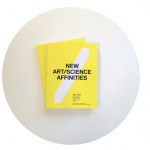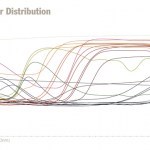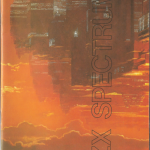Art
Dear scientists,
Why do you study, the thing that you study? What is it, and why did you choose to study it over all the other possible things you could have studied?
Best
Frank
There wasn't much color photography in Darwin's day, so all the photos we have of him are in black and white (or sepia). Here's a site with some skillful retouching of old photos to add color…and a new version of a familiar image.
(Also on FtB)
This weekend I visited the Trauma exhibition at London's GV Art gallery. The pieces all relate in some way to physical and psychological trauma inflicted on the body, by a range of artists working alone and in collaboration with medics.
Some of the items are underwhelming verging on irritating - placing histological slides on a plinth does a disservice both to art (because there is no emotional narrative contained within) and to science, because it implies that the inherent wonder and beauty of science is absent unless it is repackaged as a gallery exhibit. (Hello? Museums present objects…
Urglegurgle. I'm trying to prep a lecture on synapse formation, and just discovered that Herzog's amazing film about Chauvet cave is available…so I'm trying to scribble up technical notes on molecular biology while getting constantly distracted by 32,000 year old cave paintings. It's good to live in the 21st century, but I think my brain is getting full.
(Also on FtB)
Junior made this with his drawing tablet and Photoshop. It's him and his buddy poking each other.
Last week I had a visit from a friend of mine, who was on something of a farewell tour. After several years of planning, he'd packed in his dependable but much-begrudged corporate job, and was setting sail for Asia, to see more of the world. He's already seen much more of the world than most people. Not because he was well connected or rich, but because he made it his life's mission to tour the forgotten, the hidden and the forbidden places of the world. I mention this because if there ever was a man to take life advice from, it is this one, and he put into words something I've been…
Today I'll be writing a series of blogposts from the Falling Walls conference in Berlin. Each speaker is invited to discuss the ideas, inventions, and discoveries they believe will break down walls in their field.
Robert E. Horn: How Visual Language Supports Decision Making About Wicked Problems and Social Messes
Let's face it, having "messes" listed as a research specialism on your business card is pretty neat. But Stanford's Robert Horn is exactly that, a man who studies messes, or more accurately "inter-related sets of problems", particularly because business and government strategies…
Fifty-four years ago today, a plucky little mongrel became the world's first space pilot, taking a one-way trip aboard Sputnik 2. Here's to you, Laika.
Image: Detail of "Laika", by Phineras X Jones. Prints available from the artist.
"I read this book. It's pretty good even if they made it in a week. Worth the fifty bucks, easy."
Bruce Sterling
In February of this year, I had the distinct pleasure of being invited to the STUDIO for Creative Inquiry, a zygote of an institution nestled between departments at Carnegie Mellon University, to work on a strange collaborative project called a "booksprint." A booksprint, I discovered, is a fairly new practice, derived from the world of open-source software "codesprints." In this version, a group of writers work exhaustively for a week on a shared project, which is then made…
So BoingBoing has an item on hanging chain clocks, on sale from Ticktock Showroom at a bargain $100. I wrote about a similar art piece by Andreas Dober a year ago on these very pages, but that had a price tag of $2,338, so I'm glad to see bicycle chains have come down in price.
Here's the thing though: to my eyes, both this clock and the original by Dober are backwards. The clock is designed so that the chain takes the place of the hands as the moveable part, and thus someone decided that it should go clockwise. As a result, the numbers are printed in the opposite order to a usual clock.…
Uppåkra near Lund is Scandinavia's largest 1st millennium settlement site and may (for some definitions of "town") have been the first town north of Germany. Its finds are absolute top-quality and occur in vast numbers. For many object types, there are now more specimens from Uppåkra only than we used to have from all of Sweden. I've had the pleasure of working with some 7th/8th century brooch types from the site, and I always read news about the ongoing investigations at Uppåkra with great interest.
Now they've found something unique again. Rolf Petré calls it a mount, possibly for a…
Israel Prime Minister Netanyahu and Palestine's President Abbas gave back to back speeches last Friday at the United Nations General Assembly, a highly controversial event with Palestine's bid for formal recognition. As a scientist, such matters are far too complex for me, as they are embedded with layers of subtlety and inscrutable politics. I am much more comfortable in a world driven by logic and data.
My young children have been learning about the Israel-Palestinian conflict in various contexts and have shared these discussions with me. How can our next generation understand or process…
Self confessed geek and photographer Mark Meyer makes images that "narrate, persuade, inspire and inform". He wanted to know the exact colours present in his pack of crayons. What to do then, but put them through a spectrophotometer?
Mark says:
These questions have been nagging me since kindergarten and this weekend I finally got to the bottom of it. I am now able to answer that age-old question: what really is the difference between green-yellow and yellow-green?
Many more nerdy charts and breakdowns at Mark's website.
Bamse magazine is one of Sweden's most beloved childrens' publications, with a readership mainly about age 10. Its title character's name does mean "The Big One". But still, I must say that I was as surprised as Bamse himself and the squirrel when I saw what that troll is doing with such glee to the cow on the cover. Also, I wonder if those are silicone udders.
The "Dance Your Ph.D." contest is on again for 2011. This unusual and highly interesting experiment in science outreach continues to be shepherded by John Bohannon, and continues to attract new sponsors -- this years sponsor is TEDx Brussels.
So what is this? Basically: you create an interpretive dance that "explains" your Ph.D. research and videotape it. Sounds easy, eh? No words, no powerpoint, just dancing. And you want the audience to walk away with a reasonable understanding of what you did or are currently doing your Ph.D. on. Send in a video and John will collect them all on his…
Scandinavian Bronze Age art features a number of motifs having to do with the movement of the sun through the heavens during the day and the underworld during the night. Here on Aard, we've previously seen a recently found sun-chariot rock carving, which most likely depicts a wheeled bronze model. But more commonly, there's a horse pulling the sun's disc across the sky without the benefit of wheels. This motif is known from several rock art sites on Sweden's west coast.
Awesome rock art surveying team Roger Wikell, Sven Gunnar Broström and Kenneth Ihrestam have recently found the first two…
Joseph Hewitt of Ataraxia Theatre is the artist who rendered almost the entire ScienceBlogs stable as zombies last summer. He has submitted the third t-shirt design, and when I saw it I thought, "Screw the reader's poll, this is the one I want!". So although I'd very proudly wear shirts with the designs by Stacy Mason and Jim Allen/Sweeney too, I've decided to go with Joe's image. Keep your eyes open for a future sweepstakes.
Even in the small theater where I saw Rise of the Planet of the Apes, it was clear that this is, to some degree, a father and son movie - there were several father and son pairs in the audience - more than I've seen in any other movie. "Yes, son, now you will see why our planet eventually will be taken over by apes." "Yes, dad, now you will see how CGI replaces this Roddy McDowell person you keep talking about."
Caution: spoilers.
Andy Serkis's Caesar and the rest of the ape-men were wonderful, as was slow build of the story. I also loved that the apes' goal was not world domination but to…
Here's the second t-shirt design suggestion, from Stacy Mason! Compare the first one from Jim Allen/Sweeney.
And Barn Owl has volunteered to distribute the shirts! So unless a third design comes my way soon, I'll set up an on-line poll to decide which image goes onto the Aardvarchaeology t-shirts, and then place the order.
I miss the 80s, when computing manuals were illustrated with things far removed from home computing. I found this amongst my pop's old computing books.
Nowadays off-the-shelf programming software tends to be designed for a specific purpose, and I like to think that the artist here was trying to capture the infinite possibilties that lay ahead at the dawn of home computing, but perhaps I'm just being sentimental.
Wait, there's more!






